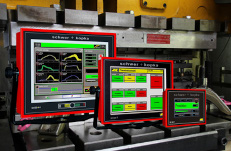Monitoring Techniques
For processes in the area of series production, monitoring the forces needed to manufacture the parts is the most suitable solution. Easy to install piezo-electric sensors measure the loads on the tools such as forming forces, cutting forces or feed forces. The real power consumption of electric drive motors is also used for monitoring.
In a learn cycle, the monitoring systems automatically memorize the typical force pattern as nominal curves for the parts that are currently running. The curve of each subsequently manufactured part is compared to the learned nominal curve and monitored for limit violations using various methods. Impermissible deviations lead to the immediate shutdown of the machine in order to avoid further defective parts and to protect machine and tool against overload. Alternatively, sorting gates are activated which automatically separate defective parts. Sophisticated algorithms ensure that even minor errors are reliably detected, while at the same time unnecessary machine shutdowns are avoided.
These are the techniques you can rely on:
Envelope Monitoring with Mandonic

The monitoring electronics automatically creates an envelope band with upper and lower limits around the learnt force curve pattern. The Mandonic automatic monitoring system dynamically adjusts the width of the band to the spread of the process: narrow where the force curves have a high repeatability and are stable, wider where the signal is more scattered. So you are sure to always work with optimal error recognition.
Thanks to the powerful signal processor, our systems work reliably with highest resolution of the sensor signals even at speeds of more than 2,000 per minute and in multi-channel applications.
By the way: all systems from our company compensate for any speed fluctuations of the machine, which would otherwise lead to lateral offset of the measured force curves and thus unnecessary machine stops.
Benefits:
- optimal, reliable detection of process errors
- monitoring reacts within milliseconds
- easy localization of the cause of the shutdown
- optionally fully automatic envelope limits
Foxmatic

Foxmatic is a unique monitoring method, which works completely independent of the set envelopes! Foxmatic uses pattern recognition algorithms to tackle those errors that are not always reliably detected or not recognized at all using traditional envelope techniques. These include, for example, sporadically occurring errors such as cracked or rotated heads in fastener production, which are normally not detected with the usual random checks. Foxmatic can thus even detect errors where the force signal remains fully within the envelope!
Benefits:
- significantly improved error detection
- yet less unnecessary machine stops
- easiest operation
- especially effective with automatic sorting of sporadically occurring defective parts
Peak Force Monitoring

For some manufacturing processes, monitoring the maximum forces occurring is the most suitable solution - for example, if the force curves tend to larger scatters. In this case, the current peak force is controlled with a lower and an upper limit. If the force value exceeds the upper limit, or if it is smaller than the lower limit, the machine is stopped immediately. The limits can be easily adapted to the current situation.
Benefits:
- suitable for monitoring highly fluctuating processes
- fast activation via a puzzle technique
- easy setting of limits
- if required, only upper or lower limit active
Trend Monitoring

Manufacturing processes can also change gradually. This does not always lead to errors, but one should keep an eye on the development. Our trend monitoring clearly shows at a glance how the process signals change over time. Easily adjustable upper and lower trend limits ensure that the process cannot move away more than allowed from the start level.
Benefits:
- less process drift
- trends can make wear effects visible
- additional safeguarding of the production process against unwanted "wandering away"
- upper and lower limits can be activated separately
- limit values either as a percentage or in absolute numbers
Monitoring Process Stability

Technical production processes always have fluctuations. For impeccable products, however, these should move within narrow limits. We measure the repeatability of the process signals (force curves) and use them to calculate the PQI factor (process quality index) as a measure of process quality. Good and stable running processes show a PQI that is close to 100%. Just set a minimum PQI to stop a swelling process in time.
Benefits:
- assurance of product quality
- protection of machine and tool in the event of unwanted changes, for example when screws or tools come loose
- easy control of the set-up quality and process reliability































